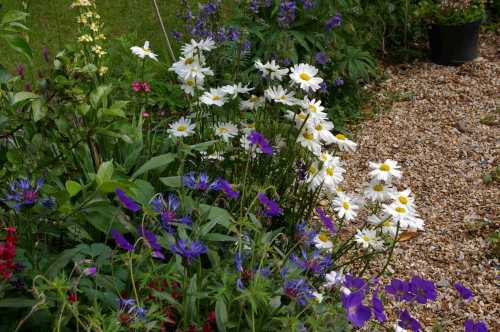Gardening For Bees In Small Spaces
I have a fairly small garden at home. However, you don’t need to have acres of space covered in flowers in order to help the bees. The trick is to make the best of what you have got. If all you have is a balcony, use hanging baskets and pots.
I once saw a wall covered in hanging baskets filled with flowers. Even a vertical wall can be turned into a feeding station for bees!
So yes, it’s not always the amount of space you have, but
what you do with it that counts. Never be discouraged and think there is nothing you can do to help bees, just because your space is limited.
Small spaces can provide habitat and food for
bees if that is what you set out to do, and they can play their part in helping to link habitats together, providing 'bee feeding stations' for hungry bees.
However, I also recommend that if you only have a small garden or yard, create something you too will enjoy! Having a garden you enjoy sitting in, and that feeds bees and pollinators, are not mutually exclusive things!
8 Tips for helping bees in a small garden

I sometimes read that the ideal garden for bees is messy and wild, but this is not necessarily true!
I have a small, informal flower patch, and I really like this informal look, but in fact, a formal garden, if planted with good nectar and pollen plants, and a variety of flower shapes can also be attractive to bees and pollinators, as long as you leave out toxic chemicals.
So here are my 8 tips:
1. Plan your garden with 'zones' to get the most out of it!
It can be tempting to created narrow borders at either side of a small space and assume you have no room for anything else, except a path running up the middle.
But on paper, why not plan a few features into your garden instead, imagining how it will look if you weave borders in and out, with miniature wildlife and bee and pollinator friendly zones.
Small zones could include perhaps:
- a bird bath surrounded by flowers (bees need water)
- a fruit/vegetable area: for example, beans can grow up vertical supports - even up a drain pipe (as they do in my garden);
- a small herb garden or area of pots filled with herbs, and remember you can also use window boxes, hanging baskets and tiered planters;
- a rockery filled with heathers.
2. Grow vertically!
Climber plants can grow up arch ways, through trees, and up drain pipes. These days we grow multiple bean plants up our drain pipe every year.
Bees love honeysuckle, jasmine, passion flower, old fashioned climbing roses, wisteria.
Choose an appropriate climber for your circumstances, and ensure the supporting structure is strong enough. Read more about climbing plants for bees.
Fruit trees can also be trained to grow against a sunny wall.
If you have a sturdy brick wall, find plants that can be grown in the crevices, such as wall flower (Erysimum), bedding campanula and various succulents.
3. Use containers
Consider using hanging baskets, pots and window baskets. Hanging basket can even be hung from trees if they are not too heavy and there is sufficient light. Some flowering plants will grow quite well in dappled shade, and will receive visits from bees.
Select tiered planters to add height and interest to 'flat' spaces.
4. Make use of your lawn!
Even if you have a small patch of grass, you can add crocus bulbs to feed the bees in spring.
In particular, clover is very useful to bees, and is pretty, fragrant, relatively neat and actually quite drought resistant.
5. Include small flowering shrubs
Compact flowering shrubs can provide efficient foraging opportunities for bees, with all the flowers available and offering nectar and pollen in one place.
The possibilities are endless, but note that some shrubs may have to be pruned yearly to keep them to an appropriate size. See Flowering Shrubs For Bees.
If you have a small garden, it's best to check the the label for information about the likely height and spread.
Good choices could include some small hebes, heathers, lavender, and various herbs.
6. Create a home!
Include a solitary bee houses in your
garden. A bird box may provide a home
for some bumble bee species.
7. Use your front garden too!
In my experience, some people forget to make good use of a small patch of garden at the front of the house.
Why not add flowers? Beach Aster, Sedum (ice plant), various creeping, flowering sempervivums could be good choices.
8. Choose plants with a long flowering season
Try to ensure long flowering seasons, and remember that some spring flowers and bulbs will die back. Their space can then be taken or covered by a herbaceous spreading plant or shrub that will flower later.
For example, I have sprawling geraniums. In early spring, the Crocus, Muscari, Daffodils and Snowdrops flower, then die back, but are eventually covered by the geranium leaves and flowers.
Further resources
See my free PDF about planning a bee-friendly garden.
If you found this page helpful or interesting, I'd really be grateful if you would share it with others - if not this page, perhaps another, such as Gardening For Bees.
Thank you so much :) .
